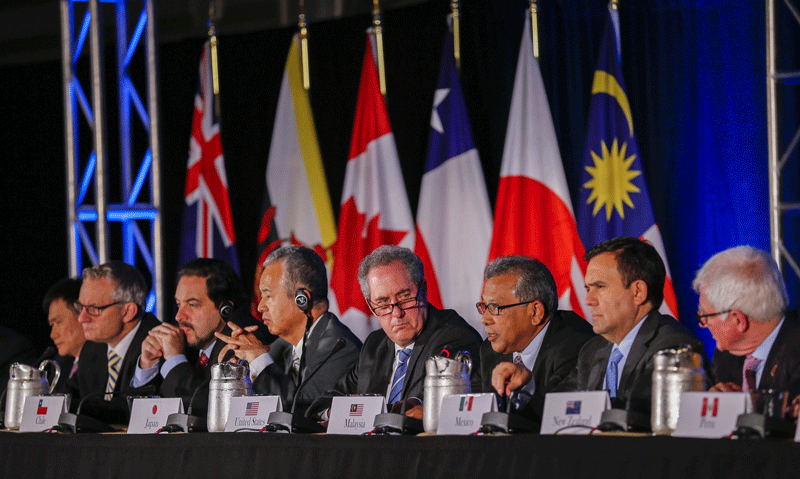After several years of negotiations, trade representatives from 12 Pacific Rim nations have reached a deal on the Trans-Pacific Partnership.
The TPP is a pact that cuts tariffs and establishes a shared set of business regulations, as well as a tribunal that allows business owners to raise disputes with member nations, without resorting to those countries’ national courts. It is also the largest trade agreement in history, and its member nations – Australia, Brunei Darussalam, Canada, Chile, Japan, Malaysia, Mexico, New Zealand, Peru, Singapore, the U.S., and Vietnam – account for 40 percent of the world’s total economic output.
The deal also marks the first free-trade agreement between Japan and the U.S. Prime Minister Shinzo Abe, speaking to reporters in Japan, said, “This is the result of two years of hard negotiations and it is a major outcome not just for Japan but also for the future of the Asia-Pacific [region].”
Final negotiations took place in Atlanta, but talks – which have been held in secret among trade ministers and international business leaders – have been ongoing for more than five years, as more nations joined in the discussion and more industries were included. Most important for Japan, which was represented by Minister Akira Amari, were agreements on vehicle tariffs and agricultural products, and during the final session of talks, which began at the end of September, several agreements between Japan and the U.S. were reached on these issues. As reported by the New York Times, over a long time – 30, 25, and 15 years for trucks, cars, and auto parts, respectively – tariffs on Japanese auto product exports will be removed.
In an additional boon for Japanese automakers, under terms of the new agreement they will be able to sell cars made from parts sourced from countries outside of the TPP zone, giving them a considerable cost advantage. A similar regulation that is in place for the North American Free Trade Agreement, which covers Canada, the U.S., and Mexico, requires that 62.5 percent of a car’s parts be sourced from within the NAFTA zone. According to Reuters, this “rule of origin” stipulation is set at 45 percent under the TPP.
Over time, some American-made cars and trucks will be allowed into Japan. Ford Motors was already quick to criticize the agreement, saying that the agreement would fall short in preventing foreign (read “primarily Japanese”) automakers from using currency manipulation to make an effective lower price for their products on on the U.S. market. “To ensure the future competitiveness of American manufacturing, we recommend Congress not approve T.P.P. in its current form,” the company said in a statement quoted in the New York Times.
One of the controversial issues in TPP negotiations for Japan have been agricultural products, most particularly rice (although butter has been on some people’s minds). Although specific terms have not been revealed, Abe addressed the topic in his remarks, saying that “we were also able to get exceptions to demands that we abolish tariffs on rice, beef, pork and dairy products.”
In addition to disagreements between national representatives over dairy and sugar markets, one of the final sticking points in the final round of negotiations was related to the length of patents that could be enforced on new biotech drugs. Pharmaceutical executives from the United States were pushing for a period of 12 years before “follow-on” versions of the medicine could be developed. Meanwhile, negotiators from Australia and Peru, pointing out the heavy financial burden that would be placed on national health care systems if they had to pay for the full-price versions of newer medicines, were asking for a far lower time period. As it stands now, a five-year minimum patent protection period has been agreed on for all biotech drugs, while a maximum for some biologics has not been set.
Of course, the elephant in all of the rooms where negotiations have been taking place over the past years is China, and proponents of the agreement have presented the TPP as a means of counterbalancing China’s influence in the region. As U.S. President Barack Obama said in a statement about the trade pact, “When more than 95 percent of our potential customers live outside our borders, we can’t let countries like China write the rules of the global economy.”
Perhaps the most looming issue now, for residents of the TPP member nations and the rest of the world, is exactly what is in the 30-chapter document that contains the full details of the trade pact. It will be about a month-long wait before the full text of the TPP agreement will be released. In the meantime, leaders from the TPP countries will have their work cut out for themselves as they try to persuade their respective governments – and constituents – to come on board.
This will not be an easy task. In the U.S., presidential candidates from both sides of the political spectrum – Donald Trump and Bernie Sanders – have already spoken out against the TPP. The “fast track” approval process for the TPP that Obama got from Congress was put under question on this site. Furthermore, given that the negotiations among national leaders and business leaders have taken place behind closed doors, it remains to be seen just what rules and regulations will be established across the TPP zone. While it looks like the powerful tobacco industry will be unable to push against antismoking laws in nations that have joined the pact, many questions remain about the influence that the agreements will have in relation to intellectual property rights, and many other issues.
–Alec Jordan
Image: Japanese Minister Akira Amari (fourth from left) sits next to U.S. representative Michael Froman (center) during the announcement of the (European Pressphoto Agency via NYTimes)









